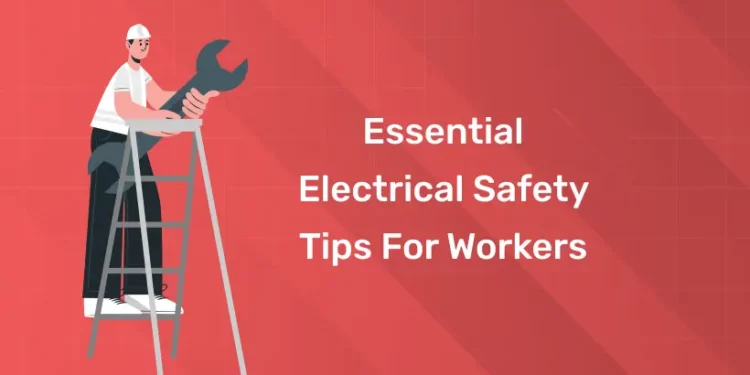Table of Contents
Working with electricity is inherently dangerous, and even the slightest mistake can lead to serious injury or fatal accidents. Whether you’re a seasoned professional or new to the field, understanding and implementing electrical safety practices is critical to protecting yourself and your colleagues. From proper equipment handling to maintaining a safe work environment, the importance of adhering to safety protocols cannot be overstated. In this blog, we will explore essential electrical safety tips that every worker should follow to minimize risks and ensure a safer working environment.
Elevate your career with our comprehensive MEP Course! Get Free Demo Here!
Introduction
Electrical safety refers to a set of measures and precautions designed to prevent accidents, injuries, and fatalities caused by electricity. It involves understanding the hazards associated with electricity and using safe practices to minimize the risks of electric shocks, burns, electrocution, fires, and explosions.
Electrical safety includes several key aspects:
- Proper handling of electrical equipment: Ensuring equipment is properly maintained, grounded, and insulated to prevent accidental contact with live wires or components.
- Use of Personal Protective Equipment (PPE): Wearing the correct safety gear, such as insulated gloves and footwear, to protect against electrical hazards.
- Safe work practices: This includes de-energizing equipment before maintenance, using lockout/tagout procedures, and following workplace regulations and codes.
- Regular inspections and maintenance: Ensuring electrical systems and tools are regularly checked for defects or damage to avoid potential risks.
- Training and awareness: Workers must be trained to identify electrical hazards, know emergency procedures, and understand how to work safely around electricity.
Electrical Safety Tips for Workers
Working with electricity poses significant risks, from electrical shocks to fatal injuries. It’s crucial for workers in any industry that involves electrical tasks to follow safety guidelines rigorously. Here are some essential electrical safety tips to protect yourself and others on the job site.
1. Always De-energize Electrical Equipment Before Work
Before starting any electrical work, always ensure that the equipment is de-energized. This involves switching off the power supply and verifying that it is truly off using appropriate tools like voltage testers. Tag-out and lock-out procedures should also be in place to prevent accidental re-energizing of circuits during maintenance.
2. Wear Proper Personal Protective Equipment (PPE)
Wearing the right personal protective equipment (PPE) can be the difference between life and death. Insulated gloves, flame-resistant clothing, safety glasses, and dielectric footwear help protect against electric shocks, burns, and other hazards. Ensure PPE is rated for the electrical task you are performing and regularly inspect your gear for any damage or wear.
3. Understand Electrical Hazards
Workers should be trained to recognize potential electrical hazards. These include overloaded circuits, exposed wires, wet conditions, and defective equipment. Proper awareness and identification of these hazards can prevent accidents. It’s also vital to understand the proximity to live electrical components and ensure a safe distance.
4. Use Insulated Tools
When working with electrical systems, always use tools that are properly insulated to protect against shock. These tools should have handles designed to prevent current from traveling through them. Regularly inspect tools for signs of wear or damage, as even minor defects can lead to accidents.
5. Keep Your Work Area Dry
Water and electricity are a deadly combination. Working in wet conditions increases the risk of electric shock. Always ensure your hands and surroundings are dry before handling electrical components, and use appropriate equipment for damp environments, like ground-fault circuit interrupters (GFCIs).
Elevate your career with our comprehensive MEP Course! Get Free Demo Here!
6. Maintain Clear Workspaces
Cluttered workspaces increase the risk of accidents. Ensure that electrical panels, circuit breakers, and other equipment are easily accessible and not obstructed by materials or debris. This helps in case of emergencies, where quick access to shut off power could prevent injury.
7. Regular Equipment Inspection
Inspect electrical equipment regularly for wear and tear. Frayed cords, exposed wiring, and faulty insulation are warning signs that equipment may be unsafe to use. If any damage is found, repair or replace the equipment before use.
8. Follow Proper Grounding Practices
Proper grounding is essential to electrical safety. Ensure that all equipment is grounded and use ground-fault circuit interrupters (GFCIs) in wet or damp environments to protect against electric shock. Grounding allows excess electricity to safely dissipate into the ground, preventing dangerous electrical buildup.
9. Follow the Lockout/Tagout Procedure
Lockout/Tagout (LOTO) is a vital safety procedure that ensures energy sources are disabled before maintenance is performed. Workers should be trained in this procedure and always follow it to avoid accidental re-energization. The equipment should be locked and tagged to indicate that it is not safe to use until the procedure is completed.
10. Stay Educated and Trained
Electrical safety training should be ongoing. Workers should attend regular safety training programs to stay up-to-date with the latest practices, equipment standards, and emergency procedures. An informed and well-trained workforce is much less likely to encounter accidents.
11. Avoid Overloading Circuits
Overloading electrical circuits can lead to overheating, fires, and equipment damage. Ensure that circuits are not overloaded with too many devices and follow the load rating recommendations for each circuit. Use circuit breakers and fuses that are properly rated for the electrical load.
12. Stay Alert Around High Voltage
High-voltage equipment requires extra caution. Workers should maintain a safe distance, avoid direct contact, and follow specific protocols when working near high-voltage power lines or equipment. Always use appropriate safety barriers and signage to mark hazardous areas.
13. Respond Properly to Electrical Emergencies
In the event of an electrical accident, knowing the right response can save lives. If a colleague experiences an electric shock, do not touch them directly. Turn off the power source immediately and call emergency services. Provide first aid, such as CPR, only if you are trained and the scene is safe.
Conclusion
Electrical safety is not just a set of guidelines but a crucial responsibility for anyone working with or around electrical systems. By following these essential safety tips—such as de-energizing equipment, wearing the right PPE, conducting regular inspections, and staying educated on potential hazards—workers can significantly reduce the risk of accidents and injuries. Safety should always be a top priority on any job site, and adherence to these practices ensures not only personal safety but also the well-being of everyone in the workplace. Stay vigilant, stay informed, and work safely.
Entri App’s MEP (Mechanical, Electrical, and Plumbing) Course offers a comprehensive learning experience for beginners and professionals seeking to advance their careers in the MEP industry. The course covers essential topics such as HVAC systems, electrical power distribution, and plumbing system design, focusing on real-world applications and practical training. It provides hands-on projects, simulations, and exposure to industry-standard tools like AutoCAD and Revit MEP.
Led by experienced instructors, the course is designed for flexible, self-paced learning, and upon completion, students receive an industry-recognized certification. This certification opens up opportunities in various roles, including MEP Engineer, HVAC Technician, and Electrical Systems Designer, making it an ideal choice for those looking to build a successful career in the growing MEP field.
Elevate your career with our comprehensive MEP Course! Get Free Demo Here!
Master MEP Design with Industry-Leading Training!
Gain in-depth knowledge of Mechanical, Electrical, and Plumbing (MEP) Design with expert-led courses. Learn HVAC, fire safety, sustainable building strategies, and BIM applications to excel in the construction industry.
Know More










